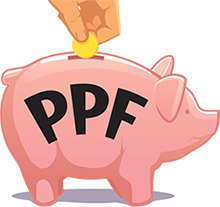
The popularity of public provident fund (PPF) comes as no surprise. Over 20 years, an annual contribution of Rs 1.5 lakh could grow to over Rs 72 lakh which is almost 48 times the annual investment (of course, the aforesaid calculation assumes a PPF interest rate of 8.5% p.a. Actually this rate is not constant but variable and market driven now). Anyhow, the assumption gives us a broad idea about the potential of PPF. And this capital built over time can serve multiple purposes like catering to the education of children, medical emergencies and even retirement.
 You would have noticed that we have mentioned that the capital grows to a substantial sum over twenty years. But isn’t PPF a fifteen year scheme? Yes, it is, however, after the initial period of fifteen years is over, one can keep on extending the deposit for a period of five years at a time. In fact, this is where the magic of PPF truly begins. One need not start a fresh PPF account and continue it for all of fifteen long years, just extend the old one for five years at a time indefinitely! This way, the same PPF account can be converted into a five year deposit and what’s more this comes with additional liquidity than what is offered during the initial term. So basically, you can convert your PPF investment into a five year deposit that offers tax-free interest, tax saving under Sec. 80C, immense liquidity and all this for your lifetime.
You would have noticed that we have mentioned that the capital grows to a substantial sum over twenty years. But isn’t PPF a fifteen year scheme? Yes, it is, however, after the initial period of fifteen years is over, one can keep on extending the deposit for a period of five years at a time. In fact, this is where the magic of PPF truly begins. One need not start a fresh PPF account and continue it for all of fifteen long years, just extend the old one for five years at a time indefinitely! This way, the same PPF account can be converted into a five year deposit and what’s more this comes with additional liquidity than what is offered during the initial term. So basically, you can convert your PPF investment into a five year deposit that offers tax-free interest, tax saving under Sec. 80C, immense liquidity and all this for your lifetime.
The PPF account can be continued after the term of 15 years either with or without further subscriptions
Examining The Rules Of PPF Extension
The PPF account can be continued (after the term of 15 years) either with or without further subscriptions. The only thing that investors should be careful of is that once an account is continued without contributions for any year, the subscriber cannot change over to with contributions extension. (Notification F.3 (6)-PD/86 dt 20.8.86)
Liquidity: An investor, continuing his account with fresh subscriptions, can withdraw up to 60% of the balance to his credit at the commencement of each extended period in one or more installments, but only one per year. (Notification F.7/2/97-NS IIdt. 9.2.1998)
For example, say the term of your PPF account is ending on 31st of March 2015. The balance at that time in the account is say Rs 15 lakh. Now, you may opt to continue the account for five more years (i.e. till 31st of March 2020) and invest regularly as you have been. However, over the period of five years till March 2020, you may withdraw only Rs 9 lakh which is 60% of the balance standing to your credit as on 31st of March 2015.
But what if you wish to continue but not invest further? In other words, you may wish to earn the tax-free interest but not wish to commit further funds. That too is possible. In case the account is extended without contribution, any amount can be withdrawn without restrictions. However, only one withdrawal is allowed per year. The balance will continue to earn interest till it is completely withdrawn. (Clarification 7 to Clause 9(3A) of the PPF Scheme, 1968)
Even non-resident Indian (NRI) can invest in PPF, provided the PPF account had been opened before the person became NRI. In other words, as per notification (GSR 585(E) dt 25.7.03), though NRIs are prohibited from opening a fresh PPF account, however, if a resident who subsequently becomes NRI during the occurrence of its term or a NRI who has opened the account before the date of this notification may continue to subscribe till maturity on a non-repatriation basis.
This means, NRIs cannot open a new account or extend the scheme beyond its maturity. Such accounts opened by mistake after the respective dates of notifications shall be treated as void ab initio. As and when, if the error comes to light, the account shall be closed and the amount refunded to the depositor is without any interest.
We were under the impression that these are aspects of PPF that are not commonly known amongst investors. However, fact turns out that some bank branches too aren’t fully aware of these rules. There was instance with one investor wherein, bank had flatly refused to extend the account and instead wanted an investor to close the existing account and start a fresh one. For other investor bank had specified that an extension will be allowed only for two blocks of five years each. After that the account will have to be closed. And in another case, the bank official specifies that post fifteen years, 60% of the closing balance may indeed be withdrawn but this has to be done at one shot, more than one installment will not be allowed. Yet another bank dictates that withdrawal after maturity has to be done in a similar fashion as it was being done during the tenure of the scheme. NRIs too aren’t spared. If the subscriptions are done through non-resident ordinary (NRO) cheque, some bank officials refuse to accept the same citing the reason that PPF isn’t open to NRIs. Of course, when you show them the rule book, the issue does get resolved. However, it is felt that given the popularity and demand for this investment avenue, some training in PPF rules will prevent valuable time of both the depositors as well as the concerned bank from being wasted.
Written By: AN SHANBHAG AND SANDEEP SHANBHAG